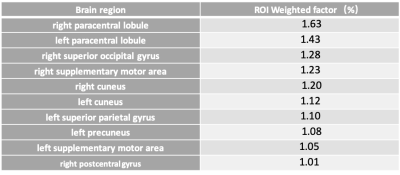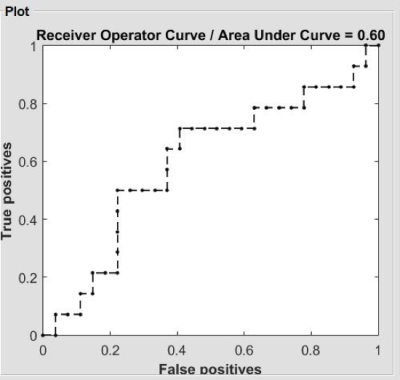1898
Evidence of altered degree centrality on patients with HIV: a machine learning approach
Danhui Fu1, Guanqiao Jin1, Lidong Liu1, Wenjuan Deng1, Sen Hong1, Qianlin Ding1, Long Qian2, Weiyin Vivian Liu2, and Danke Su1
1GuangXi Medical University Cancer Hospital, Nanning, China, 2MR Research, GE Healthcare, Beijin, China
1GuangXi Medical University Cancer Hospital, Nanning, China, 2MR Research, GE Healthcare, Beijin, China
Synopsis
Early detection of cognitive impairments in HIV carriers is essential. Neuroimaging studies has shown brain structure and function of HIV-positive patients are associated with cognition malfunction. However, the conclusions reported from previous studies are mainly based on the univariate analysis, such as t-test. In recent days, increasing attention have focused on the multivariate pattern analysis. Hence, in current study, we demonstrated the aberrant degree centrality (DC) using a machine learning approach. Our results suggested that DC might be an indicator to early detect neurocognitive impairments.
Introduction:
An approach to early HAND detection of HIV carriers is essential and desired to prevent disease-induced cognition degeneration. Compared to classification by neuro-psychometric tests, neuroimaging technology may elevate the efficiency of diagnosis and treatment of HIV-associated neurocognitive disorder (HAND). 1 HIV may affect default mode network (DMN) as an important role in self-reflection, episode searching and emotion modulation.2 Wang et al. indicated lower functional connectivity in bilateral occipital and left insular lobe in HIV-positive patients compared to normal controls.3Therefore, this study aims to examine the altered degree centrality (DC) in determining HIV-positive patients using a machine learning approach.Materials and Methods
27 HIV patients without anti-virus treatments and 14 Healthy controls (HC) were recruited. HIV-positive patients were subdivided into HIV-associated neurocognitive disorder (HAND) group and non-HAND group according to neuro-psychometric tests as reference criteria. Acquired functional magnetic resonance image (fMRI) data were post-processed with Data Processing Assistant for Resting-State fMRI (DPARSF3.1). DC values were entered into PRoNTo machine learning tool package (PRoNTo2.1.1). Then, the classification performance and the most discriminative regions could be obtained. Further, DC values of those top ten discriminative brain regions were used to distinguish patients with HAND from patients without HAND.Results and discussion:
DC values in ten major brain areas well distinguished HIV-positive patients from HC with AUC equal to 0.60 (Table 1 and Figure 1). The sensitivity and accuracy of the established classification was 100% and 65.85%. Our results also showed that several brain regions, including left precuneus, cuneus, right superior occipital gyrus and right supplementary motor area, were associated with clinical and biochemical measurements at different significant level (shown in Table 2). Precuneus is a part of default mode network (DMN), which has been reckoned as an important role in self-reflection, episode searching and emotion modulation. DMN malfunction has been found in HIV-positive patients since HIV may destruct inner connectivity and integration of DMN, subsequently leading to decrease high-level crossing connectivity. 2 Therefore, HIV-patients appear cognition impairments such asdecreased sustained attention, reduced movement pace, memory decline, working memory deficit, etc. 3 These HAND symptoms mainly in the perspective of cognition, motor and behaviors were exactly found in tests of verbal fluency, Stroop color and digit symbol in our study. In addition, the DC values in right SMA, left cuneus and precuneus were correlated with NP group, showing DC plays an important role in evaluating cognitive function.Conclusions:
DC value could be an objective clinical diagnosis indicator to early detect HAND symptoms and possibly reduce the occurrence of HAND.Acknowledgements
No acknowledgement found.References
- Schweinsburg BC,Scott JC,Schweinsburg AD,et al.Altered prefronto-striato-parietal network response to mental rotation in HIV.J Neurovirol.2012, 18(1):74–79.
- Herting M M , Uban K A , Williams P L , et al. Default Mode Connectivity in Youth With Perinatally Acquired HIV[J]. Medicine, 2015, 94(37):e1417.
- Wang X, Foryt P, Ochs R, et al. Abnormalities in Resting-State Functional Connectivity in Early Human Immunodeficiency Virus Infection[J]. Brain Connectivity, 2011, 1(3):207
Figures

Table 1 LSVM classification showed the most distinct DC values of ten major brain regions between HIV-positive group and control group.

Table 2 The correlation between ten major brain regions and clinical diagnosis indices in HIV-positive group.

Figure 1 ROC curve of DC in machine learning to evaluate differences between AIDS group and control group